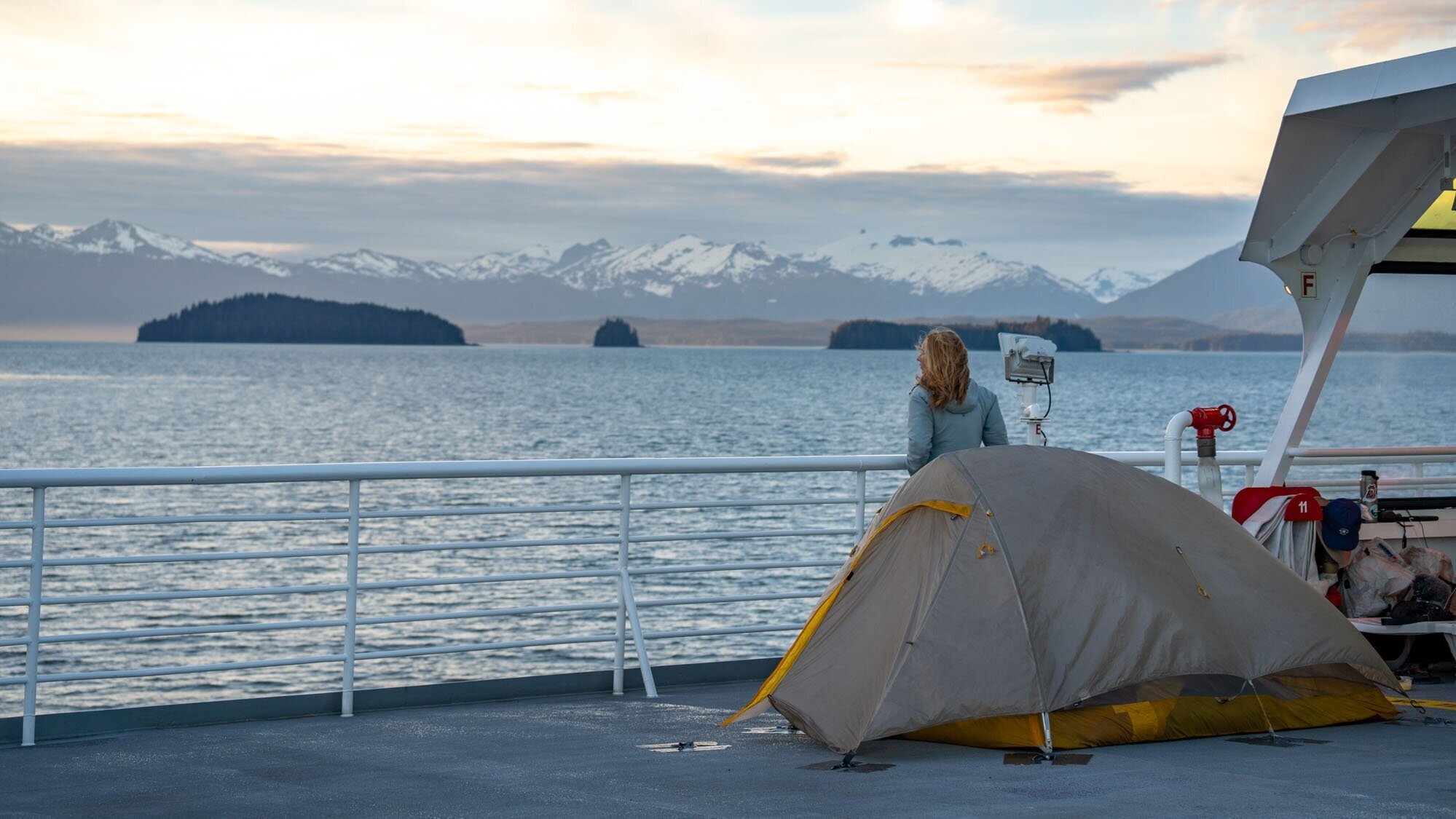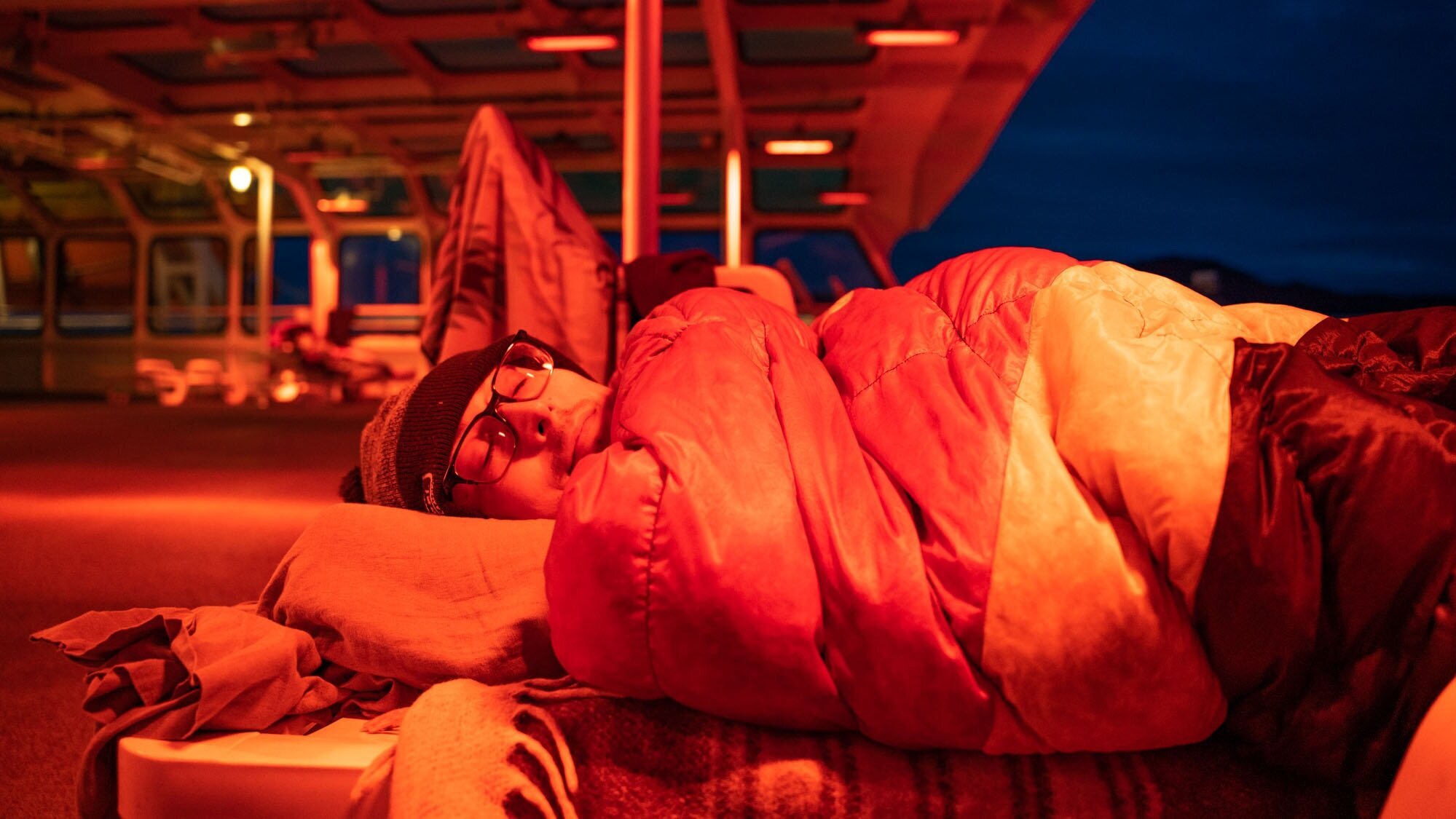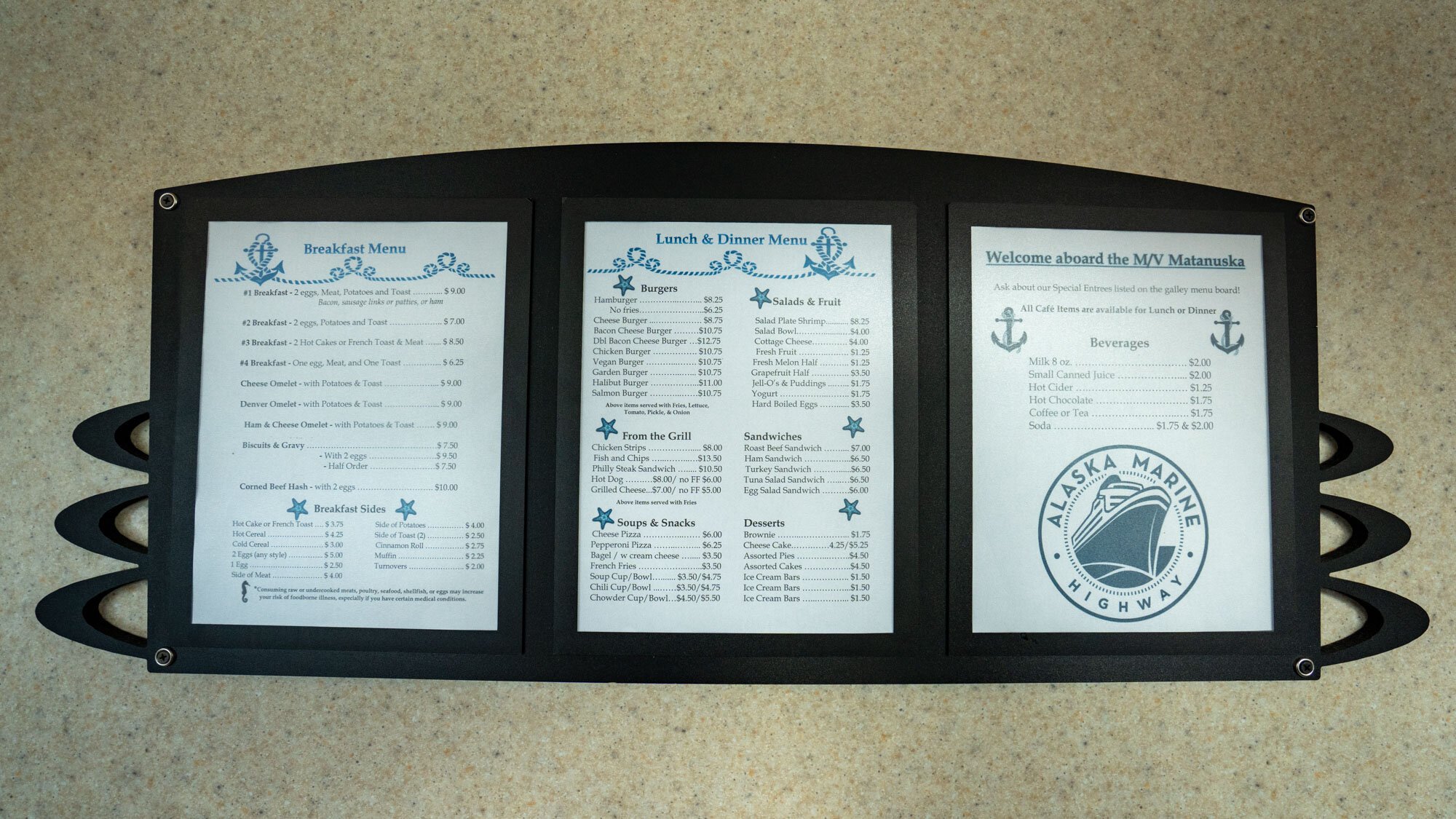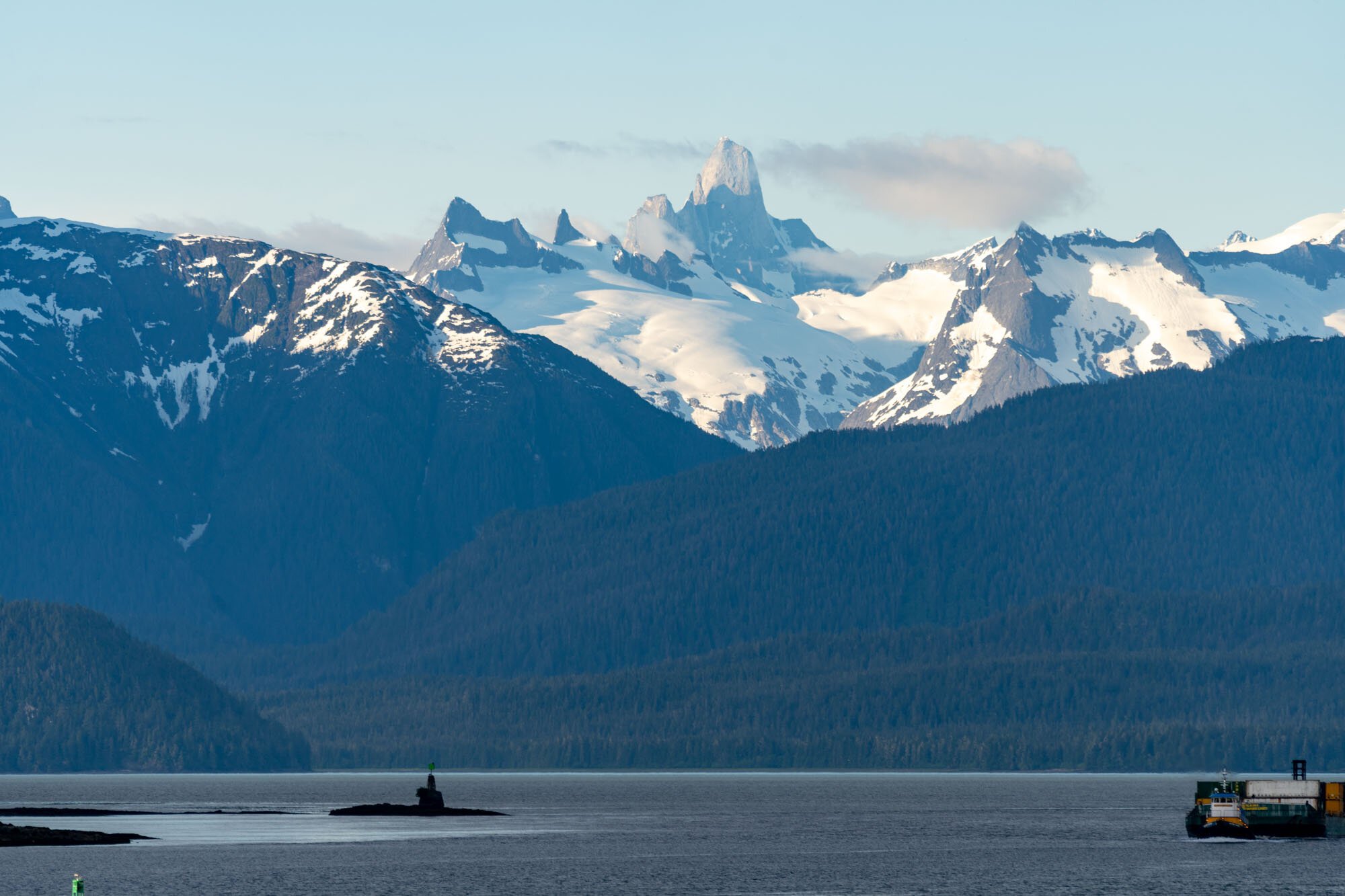How To Take The Alaskan Ferry
Hello my friends! MAK here. If you’ve been following along with our journey over on Instagram, you likely know that we’ve made it to Alaska and are filming our next video series! Since the US and Canadian borders are still closed to non-essential travel we had to get creative to get up here.
To get to the first leg of our adventure we took the multi-day car ferry also known as the Alaskan Marine Highway!
Rainbow after a brief rain shower on the tent deck. You can faintly see a double rainbow in the top left corner.
Though this blog post was brought to you by The Dyrt, however, the opinions and process are entirely our own.
Thank you so much to The Dyrt for supporting us so we can make helpful videos like this one! They’ve sent us a code to share with all of our friends for a free 90 day trial of The Dyrt Pro! The Dyrt is an awesome companion for campers looking to find camping offline, finding camping on public landings, and getting discounts on gear. Use code BFN90 so you can take it for a spin this summer as you head out for some grand adventures!
We’ve been getting a lot of questions about the ferry because it’s not a widely known option of transport to this area. When we were doing our own research we didn’t find a ton of information on things like how to prepare your vehicle, what to pack, the many ways you can sleep on board, food, boat amenities, and things of that nature. Since taking the ferry we’ve been able to clear a lot of those things up and now we’ll be able to come better prepared in the future and I want to pass that wisdom on to you all!
Owen and shadow MAK, 35mm
MAK with her duct tape handy work
Our Experience
Before we get into it, I wanted to share a little about our own personal experiences. As mentioned before, this was our backup means of transport and thus we didn’t think of it as a “grand experience”. Well, it was!
I couldn’t recommend the ferry more if you plan to explore Alaska for any period of time. It, in itself, was an incredibly intimate way to see a part of Alaska and Canada that otherwise are completely inaccessible. I will get more into the routes soon, but the ferry takes the Inner Passage, meaning that it travels in a network of passages that weave through the islands on the Pacific Northwest Coast of the North American Fjordlands. In fact, as I was wrestling our tent to the deck of the ferry, I overheard the captain say “The ferry is the only passenger boat that truly takes the Inner Passage, no matter what the cruises say.” I didn’t understand exactly what he meant by that until we got underway.
In some sections of the route, the boat had to stop in place for two hours waiting for the tide to come in to make the narrow section deep enough for us to continue. At another point, the boat had to make a tight 90 degree turn to thread us between two islands that rose high into the sky just a few hundred feet to either side of the boat. It took impressive skill to navigate and cruise ships are simply too big for this route.
If you love sightseeing and don’t love all the excess of a cruise, the Alaskan Ferry is something that will be right up your alley. I love the simplicity of waking up, having no service (or wifi), and just watching the world go by for two and a half days. On the ferry, we saw countless waterfalls, a pod of porpoises, seals, and whales. Alright, I could write about the splendors of the ferry ride all day, let’s get into some of the details.
A narrow passage ahead en route to Juneau
Routes:
The ferry system is broken into three main areas of travel. When you call to book your ticket the people there will select the right one for you. Those areas are Southeast Alaska, across the Gulf of Alaska, and South Central & Southwest. In this post we’ll be focusing on South Central Alaska, however this information will apply to any of the Alaskan Ferry regions.
South Central
Image courtesy of Alaska.gov
Here are the ports for South Central starting from Bellingham, Washington with travel times to each port
Bellingham to Ketchikan: 38 hours
Ketchikan to Wrangell: 6 hours
Wrangell to Petersburg: 3 hrs 30 mins
Petersburg to Juneau: 8 hours
Juneau to Haines: 4 hrs 30 mins
Haines to Skagway: 1 hour
Juneau to Sitka: 9 hrs 30 mins
Prince Rupert to Ketchikan: 7 hours
Juneau to Hoonah: 3 hrs 30 mins
Ketchikan to Metlakatla: 45 minutes
South Central - Gulf of Alaska
Image courtesy of Alaska.gov
Here are the ports for South Central to the Gulf of Alaska starting from Bellingham, Washington with travel times to each port.
Bellingham to Ketchikan: 38 hours
Ketchikan to Juneau: 20 hours
Juneau to Yakutat: 17 hours
Yakutat to Whittier: 22 hours
Whittier to Chenega Bay: 4 hrs 30 mins
Chenega Bay to Kodiak: 14 hours
Kodiak to Homer: 9 hours
We did the journey from Bellingham, Washington to Juneau, then Juneau to Haines a week later. Originally, we hoped to catch a connecting ferry from Juneau all the way up to any town with a road connection to the rest of Alaska. There are far fewer boats that make the Gulf crossing and sadly they were completely booked by the time we got around to making our reservation. Normally (not a time with COVID border closures), this wouldn’t be an issue because we could drive through the Yukon from Haines up to the main part of Alaska.
When you plan your own journey just be sure to keep your eyes on which town has connecting roads to other towns. Many of the towns on the South Central route are totally landlocked like Petersburg and Juneau. Others are not landlocked, but their connecting roads go through Canada. Just something to keep in mind based on what you are trying to see!
For more information about routes and travel times between ports head over the the Alaskan Marine Highway website:
Pricing varies seasonally. Naturally the summer is priced higher due to demand. The ferry also uses a dynamic pricing scale. As the boats fill up, the pricing goes up with it. In talking to others who have taken the ferry they shared that they’ve paid totally different prices. So the earlier you book, the better your price will be. Sadly, we were pretty late in booking which leads me to believe we paid a bit more for our tickets.
We booked 18 days in advance and paid $490 a person for our fair from Bellingham, WA to Juneau/Auke Bay, AK.
Our connection ferry from Juneau/Auke Bay - Haines, AK was $340 for us and the truck.
I will get more into vehicle pricing in the next section.
Roxanne tucked into place on the car deck
Taking a Vehicle on the Ferry
Taking our truck with us on the ferry was a no-brainer since we plan on spending the whole summer in Alaska. Our truck is our home, our office, it’s everything! We were worried that our truck would be classified as an RV due to the size and the propane onboard. However, much to our delight, RVs, campers and things of that nature don’t have an additional fee, instead, everything is charged based on length. The cutoff for a “standard vehicle” is 22 ft. Anything after that gets an additional charge by the foot.
Our truck is 21 feet so we paid a standard fare of $1500. The price was worth it for us because we knew we were going to be in Alaska long enough that the fare would pay for itself in savings on lodging! Again, I do think that this fee changes based on the space available on the boat. You do need to call the number 1-800-642-0066 to get the quote for your vehicle.
Our boarding passes
Something that I struggled to find in my own research was how you need to prepare your vehicle/camper. We were told that all propane needs to be off and disconnected and gas cans need to be empty. We also had to turn all power off going to the camper, which meant we spent the day before thawing and cleaning out our fridge. This was a bummer because we were hoping to have a full fridge of cheaper groceries with us when we landed in Juneau.
While the boat is underway you have limited access to your vehicle. They always announced ahead of time when you’d gain access to the car deck and for how long. We went down to our truck many times to snag things we forgot throughout the trip. This policy is primarily for pet owners to let their animals out to go to the bathroom so you can count on this happening every 6-8 hours if the seas allow for it.
Our tent on the deck of the boat
Sleeping on the Boat
My favorite part of being on the boat was being able to sleep on deck. Sounds crazy I know, but it’s truly an incredible way to experience the passage. In addition to being allowed to sleep in a tent on deck, you are also permitted to sleep in lawn chairs on the same deck as the tents, and in the public lounge areas. You can also rent cabins on the boat that range in size, price, and if they have a bathroom or not. I’ll talk about each separately.
MAK & the tent on deck enjoying the view
Tent Camping & Lounge Chairs
This type of camping is only allowed on the deck behind the solarium (as seen in the above two images). Tents have to be set up behind an obvious line, and the areas under the solarium are for lounge chairs only. All of these spaces are first come, first serve.
If you plan to camp in a tent you will want to bring an entire roll of duct tape. This is to secure your tent to the deck. I laughed when I read this on another blog, but it’s important to secure your tent to the deck because conditions can get windy and I read a few horror stories of people’s tents being blown overboard. When I went to set up our tent, the deck was VERY hot and thus our gorilla tape was heating up and peeling off. I ended up having to use a TON of tape to get our backpacking tent to stick. Even if the weather is nice you will also want to put your rainfly up because you will be traversing through a rainforest where condensation and rain showers are likely.
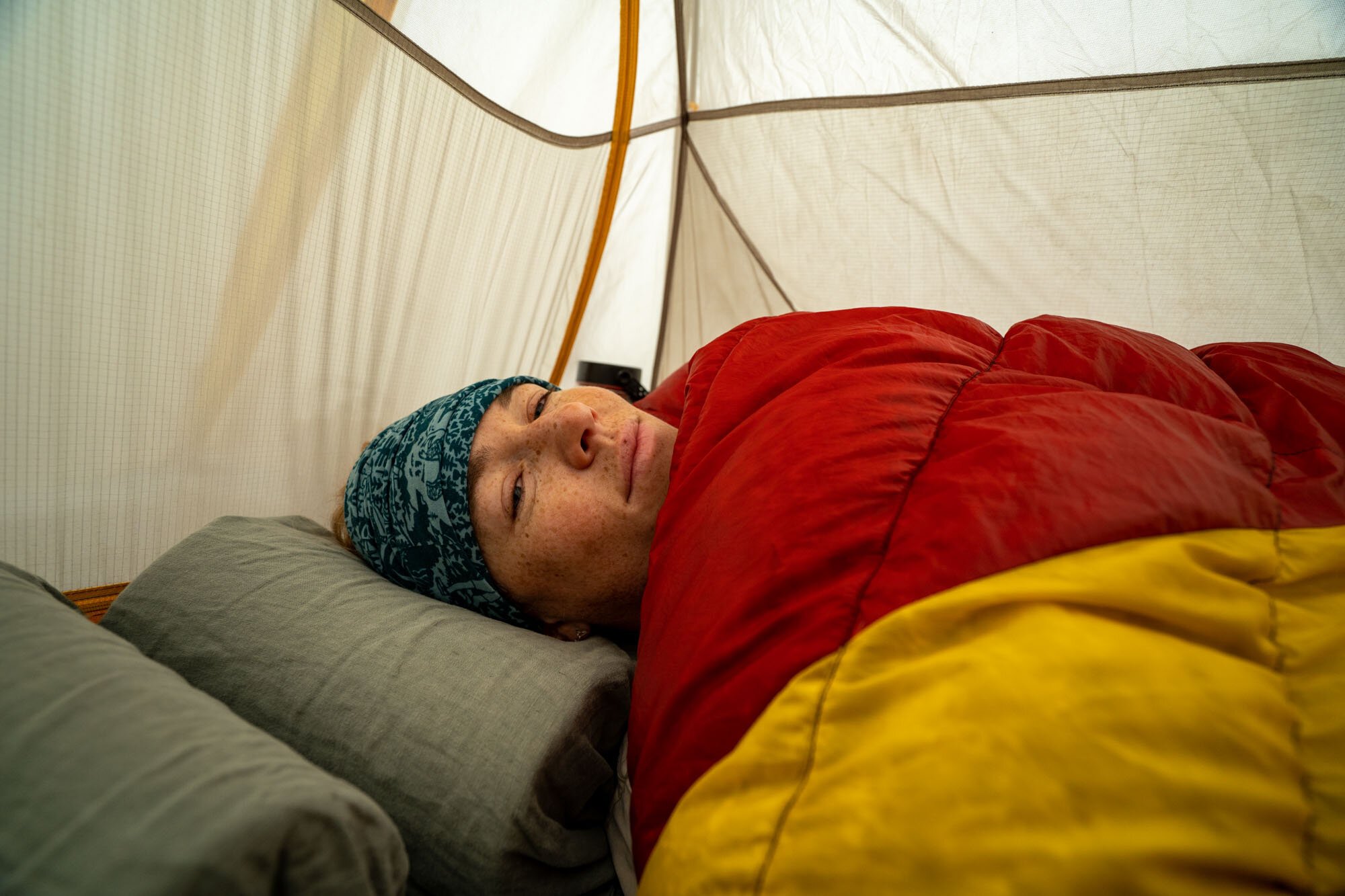
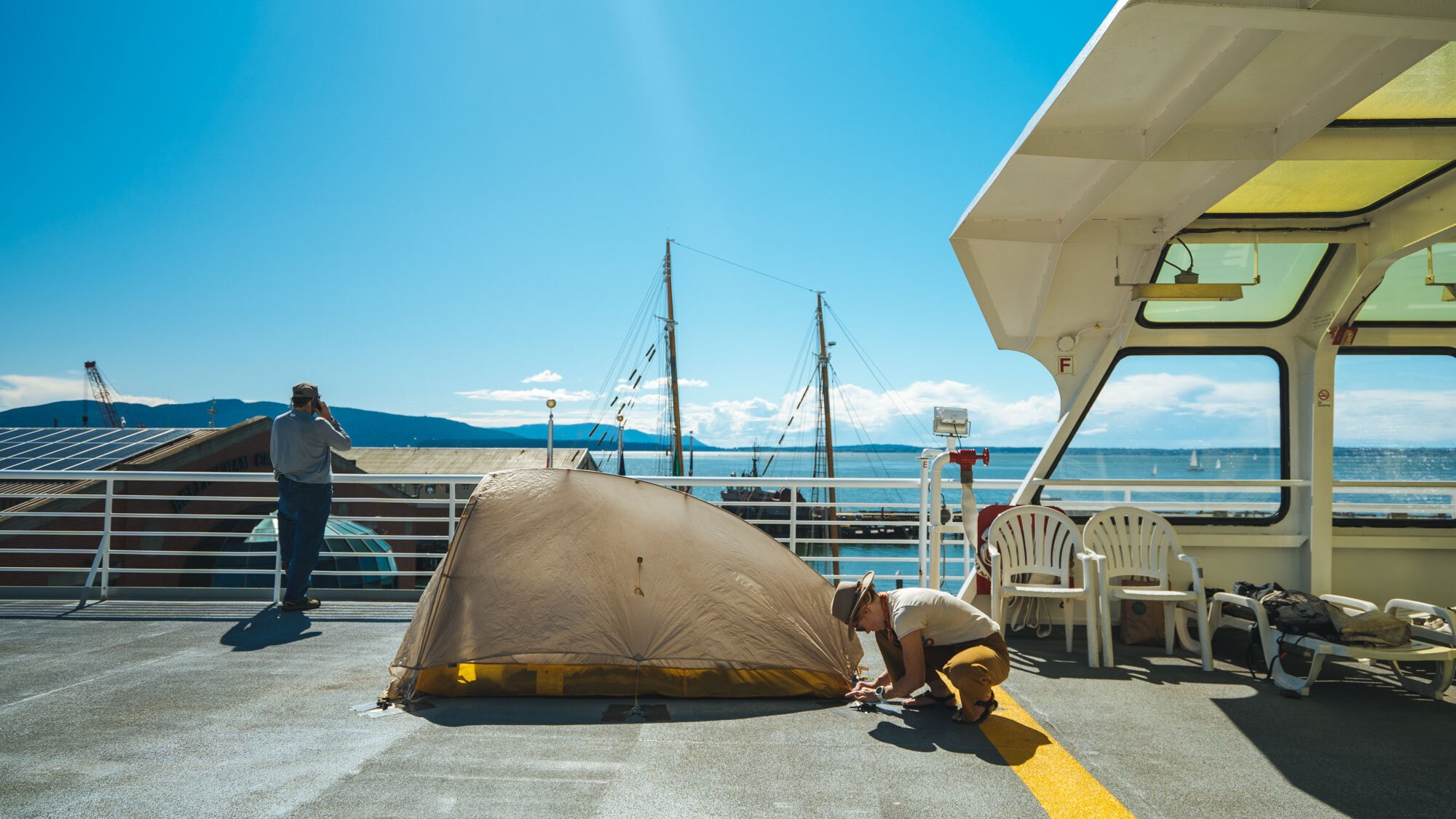
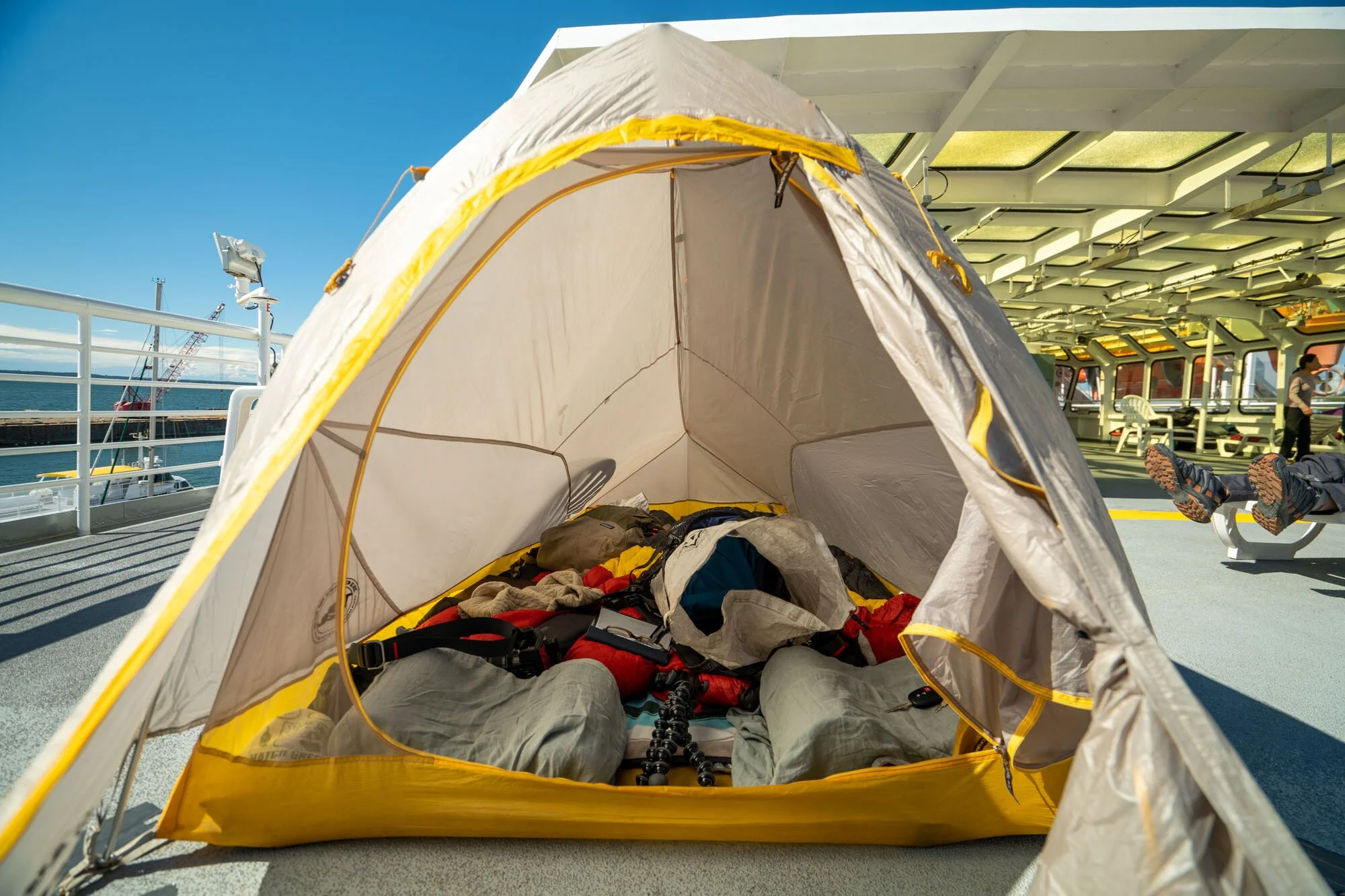
Some things you will want to bring for tent camping on deck:
Duct tape. As mentioned above.
Earplugs. You are laying your head on deck and can hear the inner workings of the boat.
Something to cover your eyes. Owen used a beanie, I used a buff. The heat lamps stay on all the time and cast a red light on the tent area.
Tent. Obviously, but if you have a choice try not to bring a minimalist tent that uses stakes in the ground as a part of its structural support. It will make setting the tent up with duct tape as stakes VERY challenging. Ask me how I know?!
Sleeping pad & sleeping bag. Duh.
Extra blankets. The ground is steel and very tough. We added an extra blanket under us for a little extra warmth. We also had two extra blankets, one on each of our lawn chairs. As tent campers, you can also reserve a lounge chair for hanging out under the solarium. When we weren’t walking around, that is pretty much where we were hanging out. In the evening it got cool so we’d sit under the heat lamps with our blankets.
If you plan on sleeping in a lounge chair, you can secure one as soon as you get on the boat at the solarium. You save your spot by tossing your stuff on one. A guy mentioned to me that on the ferry the law is “if you have something on a lawn chair, then that chair is yours”. This rang true during our passage. People really don’t mess with your things on the boat. The heat lamps are always on which is nice, even when it’s sunny out. The breeze on the deck can be cold but the minute you are under those lamps it’s a different world.
During the day there is a constant stream of other passengers that come up to hang out on the solarium deck, but it’s funny how a little full time community quickly sprouts up. Everyone chatted with each other, swapped stories, and talked about what they planned on getting into once arriving in Alaska.
In the end, it doesn’t matter which you choose between tenting or lounge chairs. I just recommend that you sleep on deck. It was unforgettable to open your eyes to a new world every morning. The scenes were constantly changing and by sleeping on deck it felt like you never had to peel your eyes away from the passing beauty. For the last night of our ferry we slept in lounge chairs so we didn’t have to break down our tent at 4AM when we arrived in Juneau. We ended up liking it so much that we opted to sleep lounge chairs rather than our tent on the ferry from Juneau to Haines. In the future, I think we’ll stick with the lounge chair just because our minimalist tent was such a pain to setup. There was also something really cozy about sleeping under a heat lamp with a slight cool breeze rustling your hair every night.
As mentioned, these are first come, first serve. If you’re getting on in Bellingham, you’re getting onto an empty boat and have the pick of the litter. If you’re traveling with a vehicle and have a travel companion, you can send one of you to walk onto the boat before they start letting cars on so they can secure a spot. We did this and it was nice because I had our tent spot and lounge chairs reserved by the time Owen drove onto the boat. Plus the tent was nearly setup by the time he made it up to the deck!
Sleeping in the Lounges
You can also sleep in the public lounge areas. They are located in various places on the boat. I saw a lady who brought an air mattress and had it laid on the ground between two rows of chairs. We also saw someone sleeping on a couch in a different room. I can’t speak about the ins and outs of sleeping in lounges since we didn’t do that. Since the weather was so nice, it felt like sleeping outside was the way to go. If we did this ferry in the winter we’d likely sleep in a lounge area as opposed to being outside.
Cabins
Again this is something that I only looked into briefly. From what I saw there are a number of factors that go into the price of a cabin such as:
Number of people it sleeps
Window or no window
Bathroom in cabin
When we were looking, a cabin for two with a window and no bathroom was going to be about $500. I know hearing that there are rooms without a bathroom is odd, but I will speak more to the reason for that in the amenities section.
Dining
Food
Food was another thing I wish I knew about before we got on the boat. I would have packed very differently if I knew what I know now. There is a full cafeteria on the boat that is open three times a day for breakfast, lunch, and dinner. They have an impressive menu for all meals including a few grab-and-go things, a full daily menu, and rotating daily specials. Owen and I got just one meal on the boat which was a dinner that consisted of two bacon cheeseburgers with a side of fries. It was solid, however, we did make a mistake in not getting the special. It looked really good. In total, our meal was $23 for the two of us.
You also don’t have to eat from the cafeteria during the ferry ride. You’re more than welcome to bring your own food. They still allow you to eat in the cafeteria, and you even have access to all their condiments, ice maker, hot and cold water, and a microwave!
We were under the impression that we’d only have access to hot water so we ate backpacker meals and cup-a-noodle for our other dinners. For lunch, we made sandwiches using the supplies we brought. And for breakfast, we just had meal bars and coffee that we made using their hot water. We were pretty content with those things.
The daily menu for your reference. Daily specials are written on a black board at the entrance to the cafeteria line.
We learned that you could use as much ice as you needed and thus could bring a cooler and refill using their ice. Knowing that and about the microwave, we might have premade some meals to reheat ahead of time and kept some beverages cold in a cooler. But ya live and ya learn!
A lot of people brought bags of movie popcorn, popped them in the microwave, and then took it up to the solarium deck to watch the sunset (total pros!). I thought this was super clever and was really jealous. Instead, I splurged (a whole $1.75) for a massive tub of pudding the last night. TOTALLY worth it!
Libations
They said that alcohol was only allowed to be consumed in your cabin and if it was seen on deck it would be confiscated. Plenty of people discreetly drank a beer here and there, but this isn’t me telling you to break the rules, just relaying what I saw ;)
Shower stall in the bathroom in the solarium
Shower stall in the bathroom in the solarium
Amenities
Showers
We were very excited to learn that there were showers on the boat. Just about every bathroom on the boat had one or two stalls to shower in. Not only can you shower for free, but you can also pick up towels from the bursar's office, which are also free! Each shower was clean and had extremely hot water. When you’re done with your towels you can toss them in a hamper in any bathroom with a shower.
It was really lovely to be able to shower right before we got off the boat in Juneau. Then when we hopped on 7 days later to go to Haines, Owen and I both showered before we even left port!
Devils Thumb, one of the most compelling mountain peaks we’ve ever seen
Outlets
The ferry boats were made in the late ’60s and early ’70s and thus are not super well equipped with plugs. The majority of them can be found in the lounge areas. People who were sleeping in the lounge areas seem to set their spot up right next to plugs so they could use them for their phones and laptops. There was one plugin in the dining room or the cafeteria, and I spotted a few in bathrooms around the boat.
Wifi
There is no wifi on the boat. We occasionally had service that we picked up from small towns and villages along the coast. I was surprised how much we had service but we went multiple hours at a time without it.
Traveling With a Pet
Sadly, we were not traveling with a pet (We miss you, Luna). Even though we weren’t, I found the process to be quite fascinating and we had some lounge chair neighbors that did, so we learned all about it.
Your pet has to stay in your vehicle at all times. Rough, I know. Pets are not allowed on deck or in any of the cabins. Every few hours they’d announce ahead of time when you’d gain access to the car deck and for how long. When the car deck was open you were given about 15-20 mins to spend time with your pet and “walk them” so they could go to the bathroom on the car deck. Yes, you read that right! The boat provides cleaning supplies to pet owners so they could clean the floor up after their pet. I heard many frantic conversations between owners and dogs trying to convince their four legged friends that they were allowed to go to the bathroom on the floor.
You’re also allowed to get off at all ports with your pet to go for a walk (you can walk around without a pet too!). The length of the stops at each port vary and were announced over the PA so you knew how long you had. To get off and back on the boat you just had to have your boarding pass on you.
Our boat, the Matanuska
*wipes sweat off brow*
Sorry for the long post, but it’s so much fun and I wanted to share all the details with you! A lot of these details I didn’t know myself, until we got on the boat in Bellingham. I hope that some of you find this helpful and take the ferry sometime. I know it will not be my last time doing it. It’s a great experience that also doubles as commuting! Win/win
Love, MAK













